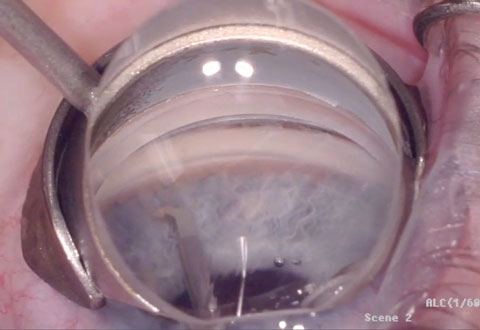 |
|
For this study, Kahook Dual Blade goniotomy was performed on various types of glaucoma, including primary open angle glaucoma (63%), primary angle closure glaucoma (26%), steroid-induced glaucoma (7%) and pseudoexfoliative glaucoma (4%). Photo: Justin Schweitzer, OD. Click image to enlarge. |
Minimally invasive glaucoma surgeries (MIGS) have been present in modern armamentariums for the past two decades. One MIGS procedure, Kahook Dual Blade goniotomy surgery, allows physicians to divert the flow of aqueous humor to the Schlemm’s canal. Since MIGS procedures are supposed to be long-term surgical solutions, researchers recently conducted a study to assess the six-year results after goniotomy treatment with the Kahook Dual Blade to better understand the clinical outcomes with a longer duration of action.
A total of 53 glaucoma patients were selected for this study and 90 eyes were operated on. Most eyes were treated with both the Kahook Dual Blade and phacoemulsification (n=72, 80%), while the remaining 18 eyes (20%) were treated with the MIGS procedure alone. After treatment, the researchers evaluated their subjects on day one, week one, and months one, three, six, 12, 24, 36, 48, 60 and 72. Only 52 eyes (58%) were available at 72 months.
The researchers set multiple parameters that needed to be met in order for the study to be a success. They analyzed the number of glaucoma medications used by patients and measured the surgical success of the Kahook Dual Blade goniotomy using the following outcomes:
- Intraocular pressure reduced by ≥20% during the final follow-up visit;
- no surgical reinterventions were required throughout the trial; and
- final IOP ≥ 4mm Hg and ≤21mm Hg.
The mean IOP was measured during the first initial exam to gain a baseline for this study. Mean baseline IOP was 18.6mm Hg. Patients who received goniotomy and phaco had a mean baseline IOP of 17.5mm Hg and those who received the MIGS device alone had a mean baseline IOP of 23.3mm Hg. After 72 months, patients who had the combined treatment achieved a mean IOP of 13.6mm Hg (27.4% reduction), the single treatment group achieved a mean IOP of 15.1mm Hg (28.8% reduction), and altogether they achieved a mean IOP of 13.9mm Hg (28% reduction).
While subjects were able to reduce their IOP by ≥20% and ended with a final mean IOP ≥4mm Hg and ≤21mm Hg, researchers reported that four eyes needed surgical reintervention at some point during the trial. Additionally, the medication burden reduced for both treatment groups. Researchers found that patients in the combined treatment group used an average of 1.3 glaucoma medications prior surgery. This reduced to an average of 0.8 medications. Similarly, the group treated with the Kahook Dual Blade alone initially used an average of 1.2 medications, which was reduced to 0.7 after surgery.
“This procedure showed favorable success, even at six years postoperatively,” stated the researchers in their study. “Kahook Dual Blade goniotomy appears to be a promising long-term therapy for correcting angle-closure and various forms of open-angle glaucoma.”
Vasu P, Abubaker Y, Boopathiraj N, et al. Clinical outcomes of excisional goniotomy with the Kahook Dual Blade: 6-year results. Ophthalmology and Therapy. August 16, 2024. [Epub ahead of print]. |


